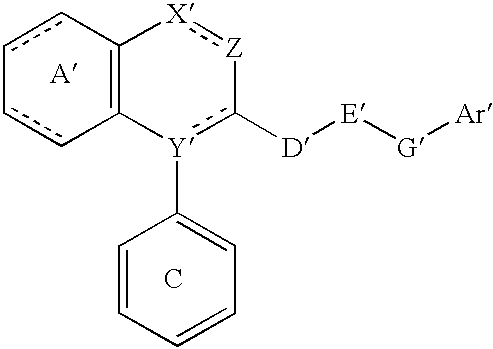Lipid-rich plaque inhibitors
a technology of lipid-rich plaque and inhibitor, which is applied in the direction of biocide, drug composition, cardiovascular disorder, etc., can solve the problems of side effects, the inhibition of acat to reduce the intestinal absorption of cholesterol is not considered to be sufficient for regressing and removing lipid-rich plaqu
- Summary
- Abstract
- Description
- Claims
- Application Information
AI Technical Summary
Benefits of technology
Problems solved by technology
Method used
Image
Examples
reference example 1
[0479]Synthesis of 6,7-dichloro-2-oxo-4-phenyl-2H-chromene-3-carboxylic acid
[0480]A mixture of (4,5-dichloro-2-hydroxyphenyl) (phenyl)methanone (1.5 g), diethyl malonate (1.28 ml) and DBU (0.25 ml) was stirred at 170° C. for 30 minutes. The reaction mixture was dissolved in ethyl acetate (50 ml), and washed with water followed by a 1 N solution of hydrochloric acid and a saturated aqueous solution of sodium chloride. After drying over magnesium sulfate, the solvent was distilled off under reduced presurre, and the residue was purified by a column chromatography (packing: silica gel, eluent: ethyl acetate-hexane=1:9). The resultant crude product of ethyl 6,7-dichloro-2-oxo-4-phenyl-2H-chromene-3-carboxylate was dissolved in acetic acid (10 ml) and concentrated hydrochloric acid (5 ml), and heated under reflux for 1 hour. The reaction solution was concentrated under reduced pressure, and the resultant residue was dissolved in a solvent mixture of THF (10 ml) and ethyl acetate (50 ml)...
reference example 2-6
[0485]The compounds of table 1 were obtained by the method similar to that in Reference Example 1.
[0486]
TABLE 1Ref.Ex.YieldMelting Point (° C.)numberR1R2R3(%)(Recrystallization solvent)2ClMeH63227-228 (AcOEt)3ClMeMe58226-227 (AcOEt)4MeMeH81205-206 (AcOEt)5MeMeMe27222-223 (AcOEt)6(CH2)4H7 92-93 (AcOEt)
reference example 7
[0487]Synthesis of (6,7-dichloro-2-oxo-4-phenyl-2H-chromen-3-yl)acetic acid
[0488]A solution of 6,7-dichloro-2-oxo-4-phenyl-2H-chromene-3-carboxylic acid (0.8 g) in THF (10 ml) was combined with DMF (1 drop) and oxalyl chloride (0.31 ml), and stirred at room temperature for 1 hour. After the reaction solution was concentrated under reduced pressure, the resultant residue was dissolved in THF (10 ml), and to which a solution of diazomethane prepared from N-methyl-N′-nitro-N-nitrosoguanidine (1.68 g) and potassium hydroxide (3.0 g) in ether (30 ml) was added dropwise. After the effervescence had ceased, the reaction solution was concentrated under reduced pressure. The resultant residue was dissolved in methanol (50 ml), combined with silver oxide, and heated under reflux for 30 minutes. After the insolubles were filtered off, the filtrate was concentrated under reduced pressure, and the residue was purified by a column chromatography (packing: silica gel, eluent: ethyl acetate-hexane...
PUM
| Property | Measurement | Unit |
|---|---|---|
| Fraction | aaaaa | aaaaa |
| Fraction | aaaaa | aaaaa |
| Fraction | aaaaa | aaaaa |
Abstract
Description
Claims
Application Information
 Login to View More
Login to View More - R&D
- Intellectual Property
- Life Sciences
- Materials
- Tech Scout
- Unparalleled Data Quality
- Higher Quality Content
- 60% Fewer Hallucinations
Browse by: Latest US Patents, China's latest patents, Technical Efficacy Thesaurus, Application Domain, Technology Topic, Popular Technical Reports.
© 2025 PatSnap. All rights reserved.Legal|Privacy policy|Modern Slavery Act Transparency Statement|Sitemap|About US| Contact US: help@patsnap.com



